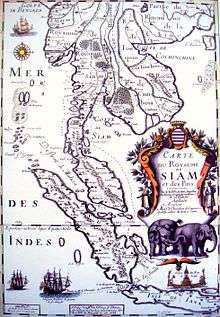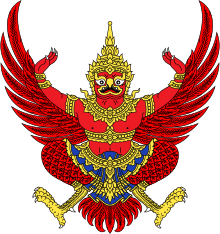Dvaravati


.jpg)
Part of a series on the |
|---|
| History of Thailand |
 |
|
Legendary Suvarnabhumi Central Thailand Dvaravati Lavo Supannabhum Northern Thailand Singhanavati Ngoenyang Hariphunchai Southern Thailand Pan Pan Raktamaritika Langkasuka Srivijaya Tambralinga Nakhon Si Thammarat Sultanate of Pattani Kedah Sultanate |
| History |
|
Sukhothai Kingdom Ayutthaya Kingdom Thonburi Kingdom Rattanakosin Kingdom Military period Democratic period |
|
Regional history |
|
|
The Dvaravati (Thai: ทวารวดี, rtgs: Thawarawadi) period lasted from the 6th to the 13th centuries. Dvaravati refers to both a culture and a disparate conglomerate of principalities.
History

The Mon Kingdom of Dvaravati, which may have existed as early as the fifth century, was controlling the Buddhist sites of Phra Pathom and Phong Tuk by at least the seventh century;[1] legends engraved on royal urns report the following kings: Suryavikrama (673-688), Harivikrama (688-695), Sihavikrama (695-718).[2] A Khmer inscription dated 937 documents a line of princes of Chanasapura started by a Bhagadatta and ended by a Sundaravarman and his sons Narapatisimhavarman and Mangalavarman.[3] But at that time, the 10th century, Dvaravati began to come under the influence of the Khmer Empire and central Thailand was ultimately invaded by King Suryavarman II in the first half of the 12th century.[4] Hariphunchai survived its southern progenitors until the late 13th century AD when it was incorporated in the Lanna Kingdom.[5] The people of the region used the Mon language, but whether they were Mon people is unknown. There is evidence that these principalities may comprise many cultural groups of people, including Malays and Khmer people. The theory of Thai migration into Dvaravati has been refuted and is now known to have happened much later.
The term Dvaravati derives from coins which were inscribed in Sanskrit śrī dvāravatī. The Sanskrit word dvāravatī means "that which has gates"[6]:301 (from dvar "door gate"). Its name may derive from the city of Dvārakā in ancient India.
Little is known about the administration of Dvaravati. It might simply have been a loose gathering of chiefdoms rather than a centralised state, expanding from the coastal area of the upper peninsula to the riverine region of Chao Phraya River. Hinduism and Buddhism were significant. The three largest settlements appear to have been at Nakhon Pathom, Suphanburi, Praak Srigacha, with additional centers at U Thong, Chansen, Khu Bua, Pong Tuk, Muang Phra Rot, Lopburi, Si Mahasod, Kamphaeng Saen, Dong Lakhorn, U-Taphao, Ban Khu Muang, and Sri Thep.[6]:303–312
The traditional chronology of Dvaravati is mainly based on the Chinese textual account and stylistic comparison by art historians. However,the results from excavations in Chansen and Tha Muang mound at U-Thong do not support the traditional dating. Newly dated typical Dvaravati cultural items from the site of U-Tong indicate that the starting point of the tradition of Dvaravati culture can be pushed back to 200 CE and lasted until 600 CE. Thus a tradition of "Early" or"Proto-Dvaravati culture" might have been established during this period.[7]
Art
Dvaravati itself was heavily influenced by Indian culture, and played an important role in introducing Buddhism and particularly Buddhist art to the region. Stucco motifs on the religious monuments include garudas, makaras, and Nāgas. Additionally, groups of musicians have been portrayed with their instruments, prisoners, females with their attendants, soldiers indicative of social life. Votive tablets have also been found, also moulds for tin amulets, pottery, terracotta trays, and a bronze chandelier, earring, bells and cymbals.[6]:306–308
References
- ↑ Coedés 1968, p. 63
- ↑ Coedés 1968, p. 86
- ↑ Coedés 1968, p. 122
- ↑ "The Mon-Dvaravati Tradition of Early North-Central Thailand". The Metropolitan Museum of Art. Retrieved 2009-12-15.
- ↑ David K. Wyatt and Aroonrut Wichienkeeo. The Chiang Mai Chronicle, p.33
- 1 2 3 Higham, C., 2014, Early Mainland Southeast Asia, Bangkok: River Books Co., Ltd., ISBN 9786167339443
- ↑ Glover, I. (2011). The Dvaravati Gap-Linking Prehistory and History in Early Thailand. Bulletin of the Indo-Pacific Prehistory Association, 30, 79-86.
Bibliography
- G. Coedès (1968), The Indianized States of Southeast Asia, Honolulu: University of Hawaii Press
Further reading
- Robert L. Brown, The Dvaravati Wheels of the Law and the Indianization of South East Asia. Studies in Asian Art and Archaeology, Vol. 18, Fontein, Jan, ed. Leiden and New York: E. J. Brill, 1996.
- Elizabeth Lyons, “Dvaravati, a Consideration of its Formative Period”, R. B. Smith and W. Watson (eds.), Early South East Asia: Essays in Archaeology, History and Historical Geography, Oxford University Press, New York, 1979, pp. 352–359.
- Dhida Saraya, (Sri) Dvaravati: the Initial Phase of Siam's History, Bangkok, Muang Boran, 1999, ISBN 974-7381-34-6
- Swearer, Donald K. and Sommai Premchit. The Legend of Queen Cama: Bodhiramsi's Camadevivamsa, a Translation and Commentary. New York: State University of New York Press, 1998. ISBN 0-7914-3776-0
- สุรพล ดำริห์กุล, ประวัติศาสตร์และศิลปะหริภุญไชย, กรุงเทพฯ: สำนักพิมพ์เมืองโบราณ, 2004, ISBN 974-7383-61-6.
- Pierre Dupont, The Archaeology of the Mons of Dvāravatī, translated from the French with updates and additional appendices, figures and plans by Joyanto K.Sen, Bangkok, White Lotus Press, 2006.
- Jean Boisselier, “Ū-Thòng et son importance pour l'histoire de Thaïlande [et] Nouvelles données sur l'histoire ancienne de Thaïlande”, Bōrānwitthayā rư̄ang MỮang ʻŪ Thō̜ng, Bangkok, Krom Sinlapakon, 2509 [1966], pp. 161–176.
- Peter Skilling, "Dvaravati: Recent Revelations and Research", Dedications to Her Royal Highness Princess Galyani Vadhana Krom Luang Naradhiwas Rajanagarindra on her 80th birthday, Bangkok, The Siam Society, 2003, pp. 87–112.
- Natasha Eilenberg, M.C. Subhadradis Diskul, Robert L. Brown (editors), Living a Life in Accord with Dhamma: Papers in Honor of Professor Jean Boisselier on his Eightieth Birthday, Bangkok, Silpakorn University, 1997.
- C. Landes, “Pièce de l’époque romaine trouvé à U-Thong, Thaïlande”, The Silpakorn Journal, vol.26, no.1, 1982, pp. 113–115.
- John Guy, Lost Kingdoms: Hindu Buddhist Sculpture of Early Southeast, New York and Bangkok, Metropolitan Museum of Art and River Books, 2014, p. 32.
- Wārunī ʻŌsathārom. Mư̄ang Suphan bon sēnthāng kan̄plīanplǣng thāng prawattisāt Phutthasattawat thī 8 - ton Phutthasattawat thī 25 (History, development, and geography of the ancient city of Suphan Buri Province, Central Thailand, 8th-25th B.E.), Samnakphim Mahāwitthayālai Thammasāt, Krung Thēp, 2547.
External links
![]() Media related to Dvaravati at Wikimedia Commons
Media related to Dvaravati at Wikimedia Commons
